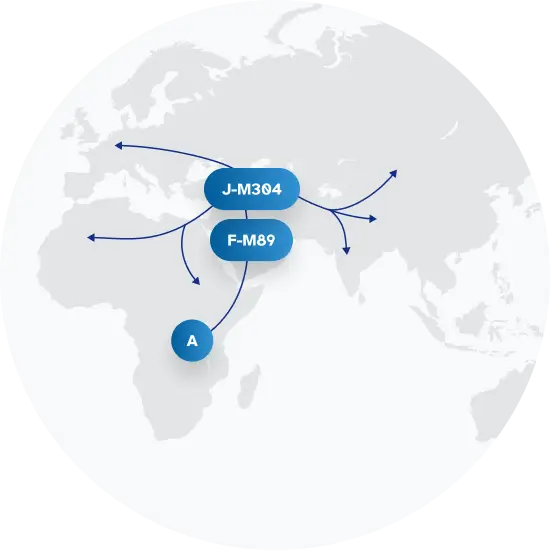Explore the Family Name Berman
How common is the last name Berman in the United States?
Based on data from the Decennial U.S. Census, the popularity of the surname Berman has seen a decline between 2000 and 2010. In 2000, Berman was ranked 1901 among surnames in the United States and dropped to 2271 by 2010, marking a decrease of 19.46%. The number of people with this last name also declined during this period from 17,346 in 2000 to 16,025 in 2010, a fall of 7.62%. The proportion per 100k people also decreased by 15.55% over this decade.
| 2000 | 2010 | Change | |
|---|---|---|---|
| Rank | #1,901 | #2,271 | -19.46% |
| Count | 17,346 | 16,025 | -7.62% |
| Proportion per 100k | 6.43 | 5.43 | -15.55% |
Race and Ethnicity of people with the last name Berman
The Decennial U.S. Census data also provides insights into the ethnicity associated with the surname Berman. Between 2000 and 2010, there were slight increases in those identifying as Asian/Pacific Islander (increased by 44.78%) and Hispanic (increased by 24.41%), as well as those reporting two or more races (rose by 12.15%). On the other hand, the percentage identifying as Black saw a substantial decrease of 26.32%, while American Indian and Alaskan Natives dropped by 50%. However, the overwhelming majority of individuals with the Berman surname identified as White in both years, with a marginal decline from 94.64% in 2000 to 94.12% in 2010.
| 2000 | 2010 | Change | |
|---|---|---|---|
| White | 94.64% | 94.12% | -0.55% |
| Hispanic | 2.13% | 2.65% | 24.41% |
| Two or More Races | 1.07% | 1.2% | 12.15% |
| Black | 1.33% | 0.98% | -26.32% |
| Asian/Pacific Islander | 0.67% | 0.97% | 44.78% |
| American Indian and Alaskan Native | 0.16% | 0.08% | -50% |
Berman ancestry composition
23andMe computes an ancestry breakdown for each customer. People may have ancestry from just one population or they may have ancestry from several populations. The most commonly-observed ancestry found in people with the surname Berman is Ashkenazi Jewish, which comprises 61.4% of all ancestry found in people with the surname. The next two most common ancestries are British & Irish (14.7%) and French & German (9.0%). Additional ancestries include Eastern European, Italian, Scandinavian, Spanish & Portuguese, and Indigenous American.
Ready to learn more about your ancestry? Get the most comprehensive ancestry breakdown on the market by taking our DNA test. Shop 23andMe
| ANCESTRY BREAKDOWN | COMPOSITION |
|---|---|
| Ashkenazi Jewish | 61.4% |
| British & Irish | 14.7% |
| French & German | 9.0% |
| Other | 14.9% |

Possible origins of the surname Berman
Your DNA provides clues about where your recent ancestors may have lived. Having many distant relatives in the same location suggests that you may all share common ancestry there. Locations with many distant relatives can also be places where people have migrated recently, such as large cities. If a large number of individuals who share your surname have distant relatives in a specific area, it could indicate a connection between your surname and that location, stemming from either recent ancestral ties or migration.
Based on 23andMe data, people with last name Berman have recent ancestry locations in the United Kingdom of Great Britain and Northern Ireland and Ireland.
| RECENT ANCESTRY Location | Percentage |
|---|---|
| Greater London, United Kingdom | 36.70% |
| Merseyside, United Kingdom | 36.50% |
| West Midlands, United Kingdom | 36.30% |
| Glasgow City, United Kingdom | 36.30% |
| Greater Manchester, United Kingdom | 36.30% |
What Berman haplogroups can tell you
Haplogroups are genetic population groups that share a common ancestor on either your paternal or maternal line. These paternal and maternal haplogroups shed light on your genetic ancestry and help tell the story of your family.
The top paternal haplogroup of people with the surname Berman is J-CTS5368, which is predominantly found among people with European ancestry. Haplogroup J-CTS5368 is descended from haplogroup J-M304. Other common haplogroups include E-L29 and E-L791, which are predominantly found among people with European and European ancestry. Other surnames with similar common haplogroups are: Gold, Feldman, Goldberg, Rubin, Goldstein, Weiss, Rosenberg, Friedman, Stern, Schwartz.
The most common maternal haplogroups of people with Berman surname are: K1a1b1a, H1, H. These most commonly trace back to individuals of European ancestry.
 Paternal Haplogroup Origins J-M304
Paternal Haplogroup Origins J-M304
Your paternal lineage may be linked to men who spread the Semitic languages
Men carrying the J-M267 lineage took part in many waves of migrations over the millennia, and domesticated animals and plants weren't the only things they carried. They may also have been among the communities that spread the Semitic languages, a diverse group that bloomed from a single proto-Semitic tongue in the Levant nearly 5,750 years ago. These men likely carried branches of both haplogroup J and of the Semitic language family through the Arabian Peninsula to the Horn of Africa. Still later, some J-M267-bearing men re-expanded from the Arabian Peninsula back through the Middle East and across North Africa in migrations associated with the emergence and spread of Islam.
Your maternal lineage may be linked to many people of Ashkenazi Jewish descent
A few branches of haplogroup K, such as K1a9, K2a2a, and K1a1b1a, are specific to Jewish populations and especially to Ashkenazi Jews, whose roots lie in central and eastern Europe. These branches of haplogroup K are found at levels of 30% among the Ashkenazim. But they are also found at lower levels in Jewish populations from the Middle East and Africa, and among Sephardic Jews who trace their roots to medieval Spain. That indicates an origin of those K haplogroup branches in the Middle East before 70 AD, when the Roman destruction of Jerusalem scattered the Jewish people around the Mediterranean and beyond.About 1.7 million Ashkenazi Jews living today (nearly 20% of the population) share a single branch of the K haplogroup, K1a1b1a. The diversity of that haplogroup suggests that it arose in the Middle East between 2,000 and 3,000 years ago, and that everyone who shares it today could descend from a woman who lived as recently as 700 years ago. A similar pattern in two other K branches, K1a9 and K2a2, as well as the N1b branch of haplogroup N, has led researchers to conclude that 40% of the Ashkenazim living today – about 3.4 million people – could descend from as few as four women who lived within the last 2,000 years.

What do people with the surname Berman have in common?
Spoiler alert: it's complicated. People with the same last name are usually no more genetically similar than a randomly sampled group of people from the same population. That said, people with the same surname are more likely to have similar ancestries than randomly sampled individuals. The reason is the tendency of people with similar cultural or geographical backgrounds to preferentially mate with one another. That's why people who share a surname may be more likely to share traits and tendencies in common than people within the general population. Check out the percentages below to see the prevalences of tastes, habits, and traits of people with your surname compared with prevalences among 23andMe users.
Preferences
Traits
Habits
Wellness
Are health conditions linked to the last name Berman?
The short answer is that, if there is an association between surname and health, it's usually more about your ancestry than your name. Individuals with a given surname are no more genetically similar than the general population but often have similar ancestries. The populations of people associated with those shared ancestries often have sets of genetic variations, also known as alleles, in common. Some of those alleles are associated with a greater likelihood of developing certain diseases.
Disease variant frequency by ancestry
Disease allele frequencies in populations associated with the surname Berman are shown below. Important Note: not everyone with a disease allele will develop these health condition

























